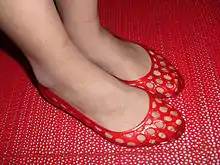Jelly shoes
Jelly shoes or jellies are shoes made of PVC plastic. Jelly shoes come in a large variety of brands and colors and the material is frequently infused with glitter. Its name refers to the semi-transparent materials with a jelly-like sheen. The shoes became a fad in the early 1980s, when a pair could frequently be purchased for less than one US dollar. Like many other fashion trends from the 1980s, jellies have been revived a number of times since the late 1990s. Although considered a populist shoe in the 1980s, the jelly shoe has been reinterpreted by a number of high-end fashion designers in the early twenty-first century.[1][2]

The exact origins of the jelly shoes are unclear. A frequently offered explanation is that they were designed by a shoe maker in France after World War II, when there was a leather shortage in Europe. Another possibility is that the shoes were created somewhere in the late 1950s or early 1960s, when plastic became a commonplace material, and fashion designers began to experiment with it. Black and brown t-bar jellies sandals were popular school wear for boys and girls in Australia during the 50s and 60s. The Brazil-based shoe company Grendene Shoes claims to have introduced the jelly shoes to the US market in 1982,[1] though a New York Times article published on June 1, 1980 also mentions them.[3]
In 1981, a bank president named Preston Haag Sr. quit his job to look for a business that would involve his family. He traveled to South America where he began visiting American ambassadors to find potential products for the United States. At a reception in Brazil, Haag noted bright shoes worn by many young women. He inquired and learned that the manufacturer was Grendene, a small company that employed 3,000 of the 10,000 people living in Farroupilha, Brazil. In March 1981, Haag struck a deal to distribute Grendene's plastic shoes in the southeastern US through a new company named Grendha, which introduced the shoes during the 1982 World's Fair. While successful, according to Haag the jellies really landed on the map in America in February 1983, after Bloomingdale's, a trendy department store in New York City, ordered 2,400 pairs in nine styles.[4]
Jelly shoes companies like Holster in Australia are now adding trending health features and benefits to the shoes as well. Holster's jelly shoes are recyclable, odor resistant and non-toxic, which have been distributed to 2,200 retail stores globally.[5] Jelly shoes are vegan-friendly and offer alternative shoes that are not made from leather. Brazilian shoe store, Melissa Shoes, opened locations in New York City, London, Spain and three locations in Florida because it experienced a continuous increase in sales regarding its eco-friendly shoes.[6] Jelly shoes come in a variety of styles such as flats, heels and wedges. They are known to be comfortable shoes for the winter, fall and spring seasons.[7]
See also
References
| Wikimedia Commons has media related to Jelly shoes. |
- Moore, Booth (May 30, 2003). "Jammin' jellies". Los Angeles Times.
- Michauld, Jessica (August 17, 2009). "The Reincarnation of the Jelly Shoe, With a Designer Flair". The New York Times.
- Alexander, Ron (June 1, 1980). "'Jelly Shoes' In Brash Colors". The New York Times. (complete text)
- Baker, Steve (March 10, 1985). "Jelly Shoes Make Success Story". Star-Banner.
- James, Caroline (February 16, 2015). "What's got jelly shoe makers talking?". The Sydney Morning Herald.
- Reiser, Emon (October 27, 2014). "Lincoln Road retailer moves from pop-up to permanent site". South Florida Business Journal.
- Sandoval, Shireen (July 30, 2015). "The Transparent Trend". WSVN.